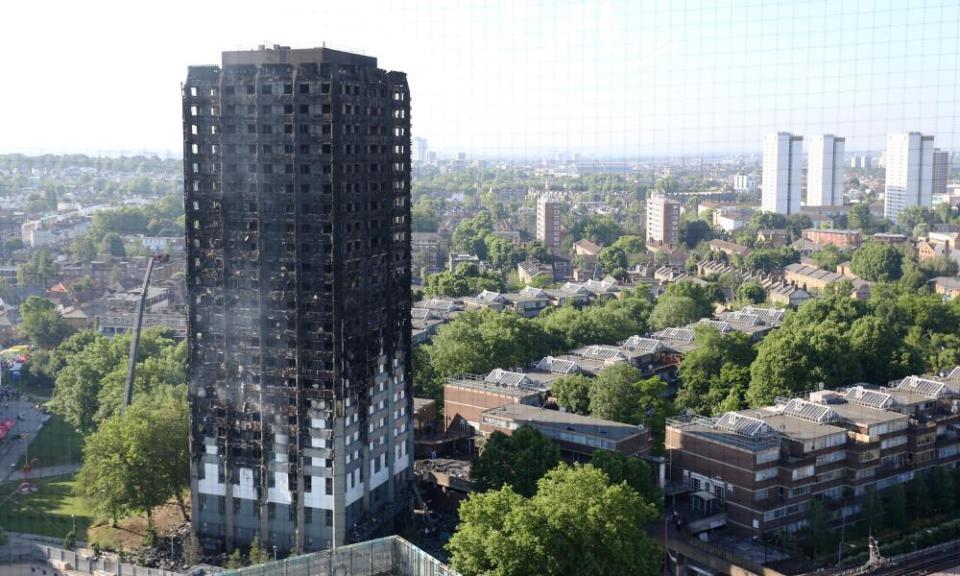Improving fire safety in high-rises after Grenfell blaze 'could take years'

Completing repair work on the hundreds of buildings that have failed fire safety tests in the aftermath of the Grenfell Tower disaster could take years due to the scale of the task, according to a government document.
In an email seen by the Guardian, a senior civil servant in the Department for Business, Energy and Industrial Strategy (BEIS) warned that new ideas and skills for high-rise building work will be required to repair the vast number of unsafe flats, schools and hospitals in the timely manner demanded by the public.
“There are a large number of high-rise residential buildings, in the public and private sectors, as well as other buildings such as schools and hospitals, where the existing cladding is likely to need to be removed and replaced to ensure the building is safe,” the civil servant wrote.
Warning that the work could take much longer than the expected timescale, he said: “These projects … typically take months to complete, and this activity can cause significant disruption to both the residents or those working in an individual building, and also to those working in or passing though the immediate vicinity.
“Therefore, it is likely that undertaking a major programme of repair and replacement of cladding using existing techniques will take years to complete, which will not meet public expectations that urgent action will be taken.”
The author of the email, Fergus Harradence, is the deputy director for construction at BEIS.
In England, 266 buildings taller than 18 metres (59ft) failed fire safety tests after the Grenfell blaze, according to the latest data from the Department for Communities and Local Government (DCLG). A spokesman for the department said all the buildings affected had implemented interim safety measures.
In order to speed up the process, £250,000 from the government agency Innovate UK has been made available to the Manufacturing Technology Centre (MTC), which develops innovation in manufacturing, to find faster ways to strip and replace building cladding that has failed fire safety tests.
The deaths of 66 people in the Grenfell fire in June have been confirmed by police, but officers have said they believe the final death toll will be about 80.
The government has tasked MTC with developing more efficient processes in areas such as plant and scaffolding, and the removal and replacement of cladding, possibly with the use of new forms of scaffolding or special purpose robots.
Technicians from MTC will work with the existing teams removing and replacing the cladding, with final recommendations to BEIS and DCLG expected by November.
The BEIS email said: “It is a government priority to ensure these repairs are delivered as quickly and efficiently as possible. The project proposed by the Manufacturing Technology Centre could, if successful, support this objective through helping manage capacity constraints through the efficient use of resources such as plant and scaffolding, and through developing more efficient techniques for removing and replacing cladding.”.
The government is hoping that any lessons learned from the MTC project will have longer-term benefits for the UK construction sector, making it more efficient and supportive of the emerging industrial strategy.
A spokesperson for BEIS said: “Following the fire at Grenfell Tower, investigations have found cladding on a large number of high-rise buildings must now be removed and replaced. The government is working with the Manufacturing Technology Centre and industry to identify possible approaches to removing and replacing this cladding, so that we can ensure that these high-rise buildings are made safe for residents as quickly as possible.”
In the aftermath of the Grenfell fire, an industry response group was established, made up of the government and the construction sector. A spokesperson for the group said it was too early to say how many skilled workers would be needed to carry out the necessary work.
“This number will depend on various factors, including a clear understanding of the number of buildings involved, the locations of those buildings, the extent and severity of the problems at each, and the range of possible solutions still to be determined.
“These capacity planning concerns are being addressed by the industry response group, who are reviewing solutions to ensure buildings are safe and the supply chain capability to cope with a rapid upsurge in remedial and refurbishment work which may follow. The group is working to find and implement solutions as quickly as possible.”

 Yahoo Finance
Yahoo Finance 